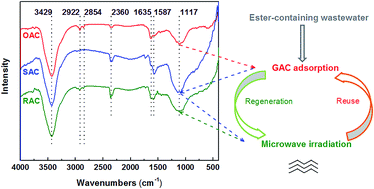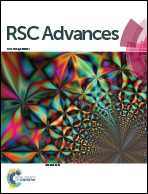Microwave regeneration of spent activated carbon for the treatment of ester-containing wastewater†
Abstract
In this study, an integrated granular activated carbon (GAC) adsorption/microwave (MW) irradiation process was used for the treatment of ester-containing wastewater from a lithium-ion battery (LIB) factory. Firstly, ester-containing organic matter was adsorbed onto GAC, then the pollutants were decomposed. The GAC was then regenerated by MW irradiation. The efficacy of this procedure was analyzed by determining adsorption effectiveness, adsorption kinetics and the textural properties of GAC in successive GAC adsorption/MW cycles. The mechanism of MW regeneration was investigated by Fourier transform infrared spectroscopy (FTIR) and thermogravimetric (TG) analysis. The results show that the adsorption isotherms and kinetics for the adsorption of ester contaminants are in accordance with Langmuir isotherm and pseudo second-order kinetic models. It was also found that though the adsorption rate constant (k2) of GAC increased with the adsorption/MW regeneration cycles, the adsorption capacity (qm) decreased where the qm of GAC at the 5th regeneration cycle had a 20.4% reduction in comparison to the determined original GAC, which could be explained by changes in the GAC's textural properties. The GAC adsorption/MW process mainly occurred at the peak of 1117 cm−1 by FTIR. Through TG and differential thermogravimetric (DTG) analyses, the weight loss of saturated GAC took place between 120 °C and 260 °C, caused by the decomposition of ester organic molecules.


 Please wait while we load your content...
Please wait while we load your content...